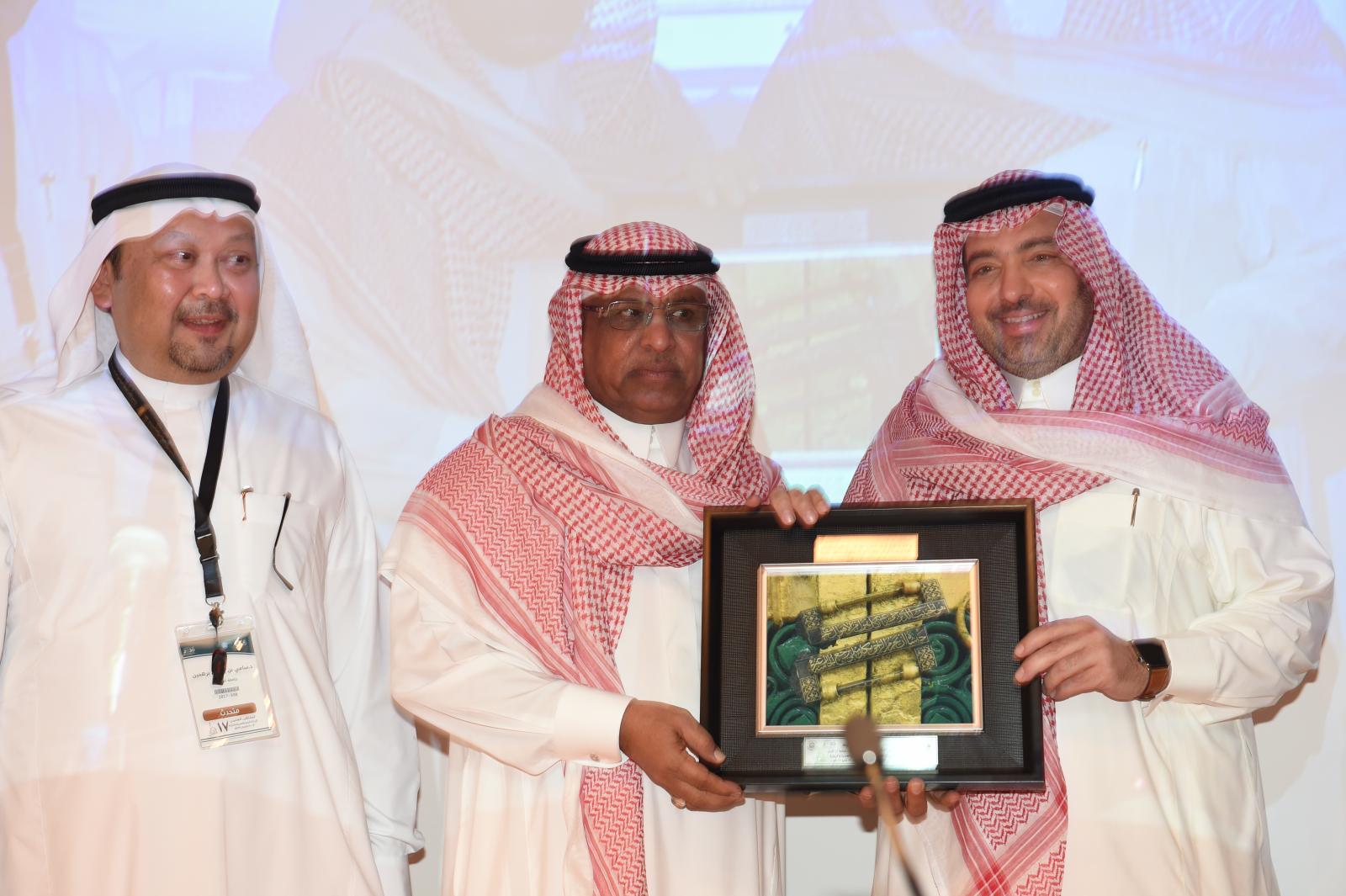
At the conclusion of their scientific sessions on the first day of the 17th Hajj and Umrah Researches Scientific Meeting, the participants examined six work sheets in the fourth session titled, “Urban and Engineering Studies,” and headed by Dr. Hatim bin Hasan Al Marzuki, President of the Islamic University of Madinah. During the fourth session, both Dr. Muhammad Wahba Ibrahim Khalil, and Dr. Muhammad Atef Elhami Kamel (from the College of Engineering and Islamic Architecture, UQU) presented a work sheet titled, “Preserving the Islamic Architectural Identity in the Urban Environment of the Two Holy Mosques.” The sheet tackled the theme of rooting for the Islamic identity of the buildings surrounding the Grand Mosque and the Prophet's Mosque. It pointed out to the significance of determining the layout of the architectural design according to the Islamic heritage data, in order to achieve harmony and integration among past, present and future patterns, and to develop a vision to rephrase such data in their contemporary sense.
The researchers also reviewed the identity of Islamic architecture and its inherent heritage values in the architecture of the two Holy Mosques. They also discussed the activation of its data within a contemporary framework to open the way to revive such data and meet the contemporary requirements to keep abreast of the multiplicity of uses of residential, commercial, hotel and administrative buildings surrounding the two Holy Mosques, and to preserve the heritage values and ensure their revival, continuity and sustainability.
In the same session, Dr. Ibrahim Abdulmohsen Al-Bedeiwi, from King Abdulaziz University (KAU) in Jeddah, presented a scientific paper titled, “Increasing Muzdalifah Absorptive Capacity via Smart Buildings.” The paper demonstrated a description of a patent issued by King Abdulaziz City for Science and Technology for a smart building in Muzdalifah, which provided a solution to the problem of narrow geographical space and unregulated stay. In the same context, the description reviewed a number of positive aspects of the proposed building and its capacity, as well as a description of the design of the building and its method of establishment.
On the other hand, Dr. Iyad bin Abdul-Majeed Al-Zaidi, from KAU, participated with another scientific paper titled, “Proposal to Expand the Visit of the Tomb of the Prophet in Medina.” Dr. Al-Zaidi illustrated a proposal based on increasing the space available for the visit in an innovative, easy and effective engineering. This would solve the problem of simultaneous overcrowding for men, women and people with special needs at the tomb of the Prophet (peace be upon him) especially during seasons. This also would increase the absorptive capacity by about 18 times, or to 88,000 visitors per hour.
In the same context, Dr. Al-Zaidi pointed out that the project worked on the use of conveyor belts outside the current place of visit on a three-stage basis. Such belts would be with horizontal, vertical, dual and unique heights and slopes, different speeds and lengths, and smart glass. He added that it allowed ultimate and permanent organization and tranquility during the visit and the honorable confrontation regardless of the location of the user. He said that the project gave the visitor time to non-stop wishing of peace for the Prophet (peace be upon him) without noise on the Prophet's room during the construction.
Then, both Dr. Muhammad Atef Elhami Kamel and Dr. Muhammad Wahba Ibrahim Khalil (from the College of Engineering and Islamic Architecture, UQU) presented a scientific paper titled, “Open Religious Squares - Case Study of the External Spaces of the Grand Mosque." In the paper, the researchers demonstrated a detailed presentation of the significance of the development of open spaces in order to promote spiritual feelings, provide safety and comfort means, and integrate more various activities. They confirmed that this would be achieved through good space management to attract more visitors. Moreover, the external spaces of the Holy Mosque should be treated as a case study, by analyzing the historical background and current situation, shedding light on the most important problems facing the visitors of such significant spaces, and providing the main visions and various alternatives to solve such problems.
Within the same framework, Dr. Sami bin Yassin Brahmin and Dr. Ayman Mohamed Mustafa (from the Custodian of the Two Holy Mosques Institute for Hajj and Umrah Research, UQU) presented a scientific paper titled, “Methodology for Building Indicators to Measure the Performance of Hajj and Umrah Facilities and Services.” The two researchers discussed the urgent need to expand indicators for measuring the performance of Hajj and Umrah facilities and services in line with KSA Vision 2030 as a planning and evaluation tool to measure progress in the steps taken towards improvement. In addition, they drew attention to the fact that such indicators’ benefit augmented when they were linked to development policies, projects were directed to meet operational challenges, and all parties concerned with the system of Hajj and Umrah facilities and services felt they had access to such indicators by participating in their preparation and usage.
This was followed by the work sheet presented by Dr. Wael Saleh Al – Halabi (from UQU) and Dr. Hamed bin Omar Al-Bar and Dr. Ali bin Yaslam Ba-Obaid (from KAU), and titled, “The number of Worshipers in the Actual Hajj Season in the Prophet's Mosque.” The researchers confirmed that the enumeration of the actual numbers of worshipers would contribute to a better perception of the pattern and intensity of the use of the Mosque's spaces and access roads. Besides, they pointed out that the arrivals to the Prophet's Mosque until the end of Friday prayers were counted. This was by regarding Friday, 22nd Dhu al-Hijjah 1437H as the peak of the second Hajj season of 1437H, while choosing Friday, 20th Muharram 1438H to represent the non-peak period.